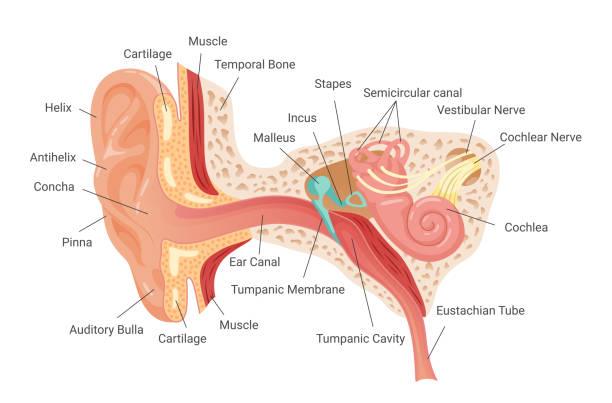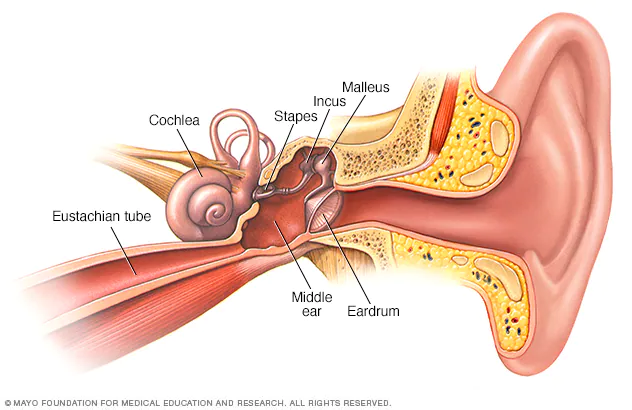Nose :-
It is first part of respiratory air way that is located in between both orbits.
Anatomically Nose heaving two openings –
A) Anterior nasal Orifies / Porse :-
nasal cavity opens exterior through anterior nasal pores.
B) Posterior Nasal Pores :-
These are located posteriorly through while nasal cavity opens in nose pharynox posterior
- It is a anatomical strcture that divide’s nasal cavity into two compartments right and left.
- Posterior half part of nasal septum is made of bone.
- Anterior half part of nasal septum is made of elastic cartilage.
Mucus Membrane of Nose :-
- It lines nasal cavity.
- Mucus secrating cell are pre.in nasal mucosa.
- Hair folids are pre. in nasal mucosa.
- Para nasal cynes (funtal cynes, maxilary cynes, ethmoid cynes) opens in nasal cavity through in nasal mucosa.
Naso Lecrimal Duct :-
- It is a tubular strcature that aries from lecrimal sac and pre in letral wall of nose.
- It Opens into nasal cavity.
- Different bone that folds wall of nose are –
- Nasal Bone’s
- Ethmoid Bone
- Maxilla Bone
- Nasal Concha
- Womer
Functions :-
1.Transportation:- Air during inhalation and exhalation transmits transmits through nose.
2. Filtration :- Dust particles are traped nasal mucosed.
3. Humidification :- In healed air become most when it comes in contact with mucus.
4. Warmification :- In healed , air becomes warm when it comes in contact with mucus membrane.
5. Resonence :- Nose provides resonance to voice to voice ( para nasal cynes P.N.C. )
6. Allfection :- Nerve ending of allfectory nerve are pre. in mucus membrane of nose.
Nerve ending stimulats when desolved small particles comes in contact.
As a result dipolerization occures and impulse generate.
Generated nerve impulse conduct upto allfectory centres that are pre. in brain (ceribrum)
Sense of small occurs after inter pretation.
Trachea :-
- This is a cartilaginous tube between the larynx and the lungs. It is a made of C is placed at the back and is covered by fibrous tissue.
- The cartilage rings hold the trachea open for the passage of air. The goblet cells secrete mucus.
Larynx :-
It is also known as voice box .
It is a part of respiratory air way that is pre. in mid axis of Neck.
Superiorly it is continous as pharynx while inferiorly its continous as trachea.
Anatomical Relation :-
Anterior :- Skin , superficial fascie difascia.
Letarly :- Thyroid lobes and carotid verseles, nerve fibers.
Superiorly pharynx, hyoid bone
Inferiorly :-
First tracheal cartilage wall of larynx:-
wall of laynx consist cartilages.
Cartilages are inter connected with the help of ligaments are –
Unpaired cartilage
- Epiglotis
- Thyroid
- Cricoide
Paired cartilage
- Arytenoid cartilage
- Corniculate cartilage
- Cunieform cartilage
1. Nine cartilages are pre. in wall of larynx.
2. Epiglotis is a elastic cartilage
3. It is a lid like structure that closes in-large of larynx during deglutition (swalowing)
4. Thyroid cartilage having two plates.
5. Both plates form in accute angle in mid axis of Anterior wals of larynx.
6. This angle is more prominant in male and it is called adams apple.
7. Cricoad cartilage is a ring shaped cartilage that is pre. below to thyroid cartilage and above to first tracheal cartilage.
8. Arytenoid cartilage is a paired cartilage and pre. in posterior wall of larynx.
9. It is conical in shape .
10. Corniculate cartilage is a paired cartilage and pre. in posterior wall of larynx.
11. Couniform cartilage is also a paired cartilage and pre. in posterior wall of larynx.
Mucus Membran :-
1. It is inner most layer of larynx.
2. It lines larynx interiorly.
3. Ciliated columnor epithelial cells lines mucus membrane. Mucus secrating columnor cells.
4. Blood vessels, nerve fibers, limph vessels and lymphoid folids are fire is sub – mucosal resion.
5. Mucus membrane is modified and forms folds.
6. The fold of mucus membrane that are pre. in inlate of larynx are called fowls vocal cord.
7. Another two folds of mucus membrane pre. below to fowls vocal cord are called true vocal cord.
8. True vocal cord are arranged in ‘V’ shaped.
9. Anteriorly vocal cords are attached with a thyroid cartilage.
10. Posteriorly attached with arytenoid cartilage. Vocal cords are related to voice production.
11. A space that is pre. in between true vocal cord is called rimoglotis.
Blood Supply :-
Arterial supply vein – laringial artry , laringial vein
Nerve supply – recrunt laringial nerve.
Functions :-
1. It transports air during inhalation and exhalation .
2. Humidification
3. Warmification
4. Filtration
5. Phagasytosis:- Tymphoi[ez-toc]d folids form antibodies and lymphocyte cells that degrate micraps.
Voice Production :-
Vocal cords are pre. in larynx that vibrats during forcefull flow of air and voice production accure high pitch voice production occures in female as more cords.
– Lord voice production or low pitch voice in male is due to low tendency in vocal cord.
Trachea :-
Defination :-
It is a wind pipe that pre. in mid axis of neck and in superior or media sternum.
It is a tubular structure that is pre below to larynx and runs down word up to cornia.
Length :-
It’s normal length is 10.5 cm
Anatomical Relations :-
Anterior :- Skin , superfacial fecia and deep facio
Laterly :- curotid vessels
Superiorly :- Larynx
Inferiorly :- Bronchus
Posterirly :- Essophagus
Blood Supply :-
Arterial :-
1. Branches of inferior thyroid artery
2. Lower part is supplied by Branches of Bronchia artery
Veinus Collection :-
1. Vein yellow artery
2. Nerve Supply – Autonomic nerve intervent.
Histology :-
Histologicaly different layers are pre. in it’s wall
A) Fiberus Layer (outer) :-
It is made of fibrous connective tissue
B) Cartilagenus Layer :-
C – shaped cartilages are pre. in this layer
Skin area of cartilage is directed posteriorly.
Tracheal muscles is pre. in skin area.
C) Sub-mucosal layer :-
It is made of arealor connective tissue.
Blood vessels, nerve vessels , nerve fiberus , lymphoid fluids are also pre. in this layer.
D) Mucus membrane :-
It is inner most layer that is lined up by ciliated columnar epithelial cells
Mucus secrating cells are pre.
Function:-
- Transportation of air
- Humidification
- Warmification
- Filtration
- Phagacytosis
Bronchus :-
Defination:- It is a part of a respiration airway that are pre. in medisternum. There are two branches – Right and Left
- Both Branches aries from trachea
- Terminal end of Bronchus enters in lung through root of lung .
- Each Bronchus devides in secondary Bronchealus
- Two in left side and three in right side.
Blood Supply :-
Broncheal Artery
Veinus Collection – Broncheal vein
Nerve Supply – Autonomic nerve ineratis
Histology :-
A) Fiber’s layer(outer)
B) Cartilagenus Layer :-
Broncheal muscles are pre. in skip area.
C) Sub Mucosa
D) Mucus Membrane
Function :-
- Transportation
- Filtration
- Humidification
- Phagocytosis
Broncheal Tree :-
- Primary Bronchus inters in lung paranchyma through root of lung.
- Primary Bronchus divide in secondary and tersory bronchus
- Tersory bronchus ferther dicide 5-6 types.
- As bronchus divide it’s lumane becomes narrow and size of cartilage becomes small.
- Size of broncheal muscles becomes large.
- At the level of respirotry broncheal cartilage is absent in it’s wall.
- Broncheal muscle’s ancirkil wall of respiratory broncheal.
- Respiratory bronchioles opens in alveolar duct and alveoli.
Alveoli :-
- It is a terminal part of respiratory air way in which alveolar duct’s open.
- It is conical in shaped.
- It’s base is directed toward’s peripharilly while apex is directed towards root of lung.
- Lung alveoli is lined up by squamus epithelial cells.
Also Read this
and this also









 Structure of medula
Structure of medula















































